Implant Dentistry
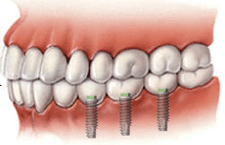
Implants offer the comfort, appearance, and function of natural teeth.
Dental implants are rapidly changing the way people live and are one of the most important advances in modern dentistry. They offer a patient, who is missing one, several, or all of their teeth, an excellent alternative to partials or complete dentures. Implants offer the comfort, appearance, and function of natural teeth.
What Are Dental Implants?
A dental implant is a small titanium cylinder that is surgically placed into the upper or lower jawbone and serves as a root substitute for a natural tooth. During a 4-6 month healing period the bone will fuse to the implant and anchor it in the mouth. These anchors provide a strong foundation for replacing single or multiple teeth. For over 30 years implants have resulted in beautiful smiles for patients. They result in a more natural type of tooth replacement that can restore your previous chewing ability, improve appearance, and renew self-confidence.
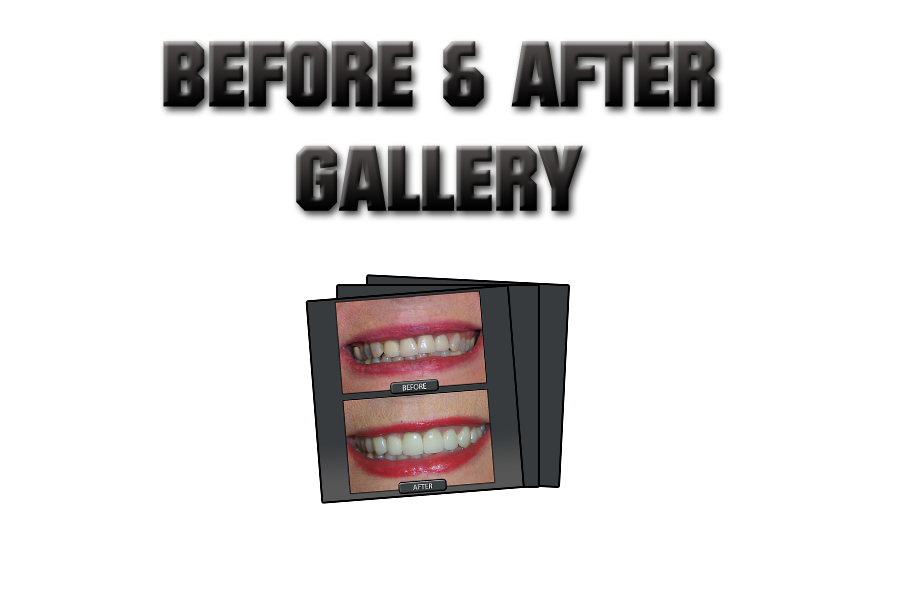
What Can Implants Do For You?

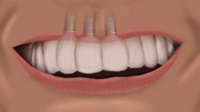
The Surgical Procedure
The placement of dental implants most often involves two surgical procedures. First, implants are placed within your jawbone. The implants remain below the surface of the gum for a four to six month healing period and gradually fuse to the jawbone. You can continue to wear your dentures or temporary teeth during this time.
After the implant has bonded to the bone or "osseointegrated", Dr. Hoar performs a minor procedure to uncover the implants. Small posts are attached to the implants. These posts project through the gums and will serve as anchors for the replacement teeth (Photo A Below). The entire procedure takes six to eight months. Most patients experience very little disruption from their normal life patterns. Cases that require bone grafting due to inadequate bone for implant placement would require additional healing time.
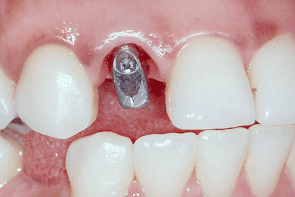
Showing posts through gum tissue

Showing completed implant case
Bone Grafting
Most patients do not realize that tooth loss results in immediate bone loss in the jawbone and that this process of resorption continues over time. Eventually, there is inadequate bone quality or quantity for implant placement.
Today bone can be grafted to a deficient site, so that new bone can develop. This gives us the opportunity to place implants and the opportunity to achieve a more natural function and appearance.
Sinus Life Procedure
Once teeth are lost in the upper jaw, the sinus expands or increases in size. This results in the loss of bone height and the ability to place implants of proper length in that area. The sinus can be easily modified by elevating the sinus membrane and placing a bone graft on the sinus floor. This is a routine procedure that is done with minimal post-operative discomfort. Most people express the ability to breathe easier as well.
Ridge Augmentation
Traumatic accidents or tooth loss can result in deficiencies or loss of bone width. This means that the jawbone is not wide enough to place implants. A block of bone can usually be taken from the back of the jaw or the chin and grafted in the deficient area. This provides a source of new bone and increased width. Post-operative discomfort and recovery time is usually minimal.

Bone Sources
It is best to use the patients' own bone, which is called autogeneous bone to achieve optimum results. This is well supported by the current implant literature. Bone grafts can usually be taken from inside the mouth, in the area of the third molars, the chin, or even the upper jaw behind the last tooth.
Cosmetic Dentistry
A smile can be the most eye-catching feature of your face. Discolored, chipped or crooked teeth can be corrected through modern advances in dental technology. Dr. Hoar's skills span almost 40 years of clinical experience in the art of cosmetic dentistry.
Bleaching
Bleaching can whiten teeth that are discolored or stained and can be done in approximately 1 1/2 hours with our in-office "power bleaching". A custom made tray is then fabricated for your mouth that holds a bleaching gel, which is placed over your teeth for continued at-home bleaching. Treatment time will vary depending on your teeth and the type of result you are expecting.
Veneers/Laminates
Porcelain Veneers are egg shell thin porcelain coverings placed over prepared teeth in order to correct things like size, shape , position, color, and wear. To achieve a natural look with porcelain veneers Dr. Hoar personalizes individual characteristics. This is achieved through masculine or feminine tooth arrangement, proper lip support and determination of a pleasing smile line for your facial contour. One other key aspect in obtaining a natural looking smile is the type and shade of the veneered teeth and the ability and skill of the laboratory technician. This technique is popular among models, actors and actresses because of the beauty and longevity these restorations offer. In fact, Dr. Hoar uses the same laboratories in Hollywood that make the stars teeth. The time to complete the procedure can be as little as two weeks. Straight, white perfect teeth can take 10-15 years off of your appearance.
Ceramic Restorations
Natural tooth-colored fillings have become widely accepted and are often used in place of metallic restorations where aesthetics is a primary concern. There are even studies that show the use of certain tooth-colored materials can strengthen a tooth, making it a better choice than the metallic predecessor - amalgam. The type of tooth-colored restoration used most often in our office is ceramic.


Ceramic Restorations
Ceramic fillings come in several different types that can be used for different situations. Ceramics are typically used for the larger and more broken down areas. In these cases, an inlay or onlay to cover more of the tooth's surface may be indicated. These restorations are indirect because they require two visits and fabrication by a dental laborato y. Ceramic restorations are much more durable than composites and will not stain. Naturally speaking, the final result with cermics is spectacular.
What About Cost?
Like all purchases, cost is relative to value. To some, a $100,000 luxury vehicle is an inexpensive acquisition, while to most of us, it is expensive. The same holds true for cosmetic dentistry.
The cost of cosmetic procedures can vary from as little as $300 to as much as $50,000. That is because cosmetic procedures run the gamut from tooth bleaching, to complex and accurate resculpting and restoration. You can start with a simple and modest procedure at minimal expense. The best approach may be to schedule a brief consultation to discuss your desired smile improvements.
Restorative Dentistry

Fixed Crown & Bridge
Missing or broken teeth can be restored with porcelain bridges or single crowns. Dr. John Hoar offers a functional and appealing solution to these problems.
Crown or Caps
A crown looks like a tooth and is hollow inside, like a thimble. The crown is usually made of porcelain that is fused to an inner metal core. Crowns are used to strengthen weak teeth and to improve aesthetics. They are indicated for teeth that have large fillings, broken teeth, and teeth treated with a root canal therapy that become quite brittle.
The compromised tooth is prepared by reducing its size, so that the crown can be cemented over it. The crown is constructed in the laboratory from an impression of the prepared tooth according to our exacting specifications. Dr. Hoar uses all porcelain crowns for front teeth to achieve extremely natural looking results.
Fixed Bridgework
Teeth were designed to compliment each other. When a tooth is lost, the nearby teeth may shift toward the empty space, or the teeth in the opposite jaw may move up or down toward the space. This places unusual stress on both the teeth and tissue in your mouth, which results in fractured teeth, periodontal disease, and joint problems.
A bridge is used to replace one or more teeth and is permanently cemented in the mouth. The teeth adjacent to the missing teeth are prepared or reduced in size and serve as anchors for the fixed bridge. The patient wears a temporary acrylic bridge for a short period of time so that a permanent bridge can be fabricated in the laboratory. The bridge is ultimately cemented to the prepared teeth with a dental cement.
A bridge offers a very aesthetic and quick replacement for missing teeth. It improves appearance, self-confidence and helps eliminate future dental problems. It provides a more stable bite with excellent function, comfort, and esthetics. However, in each case it should be determined whether the most advantages treatment for the patient should be a bridge or individual supporting implants.
Some patients dislike the idea of preparing or reducing their natural teeth to receive a fixed bridge. Other options are available including the more natural look and feel of a dental implant.
Oral Sedation

How does it work?
You are given a small pill to take an hour prior to your dental appointment. Your companion will accompany you to the office. By the time you arrive you will be very drowsy.
When you arrive in our office, you will be escorted into a comfortable room, covered with a blanket and placed on a monitor to watch your vital signs. After you are comfortable Dr. Hoar and the experienced clinical team at The Center for Implant Dentistry will take care of your dental needs.
When your treatment is completed your companion will return you home to finish your comfortable, relaxing day.
Facts About Oral Sedation
1. It Really Works! You really can rest comfortably through your dental appointment.
2. It Is Safe! You take a small pill prior to treatment, no intravenous tubes or needles.
3. You will probably have little or no memory of the experience. You probably won't even remember any sounds or smells.
4. You often times may sleep for up to five to six hours after taking the pill. The time you are asleep will vary depending on your needed treatment.
5. Complex dental treatments that often require prolonged appointments, can be done comfortably.
6. People who have difficulty getting numb will probably have no problem when relaxed.
Commonly Asked Questions About Oral Sedation
Q. Will I feel any pain?
A. No. You will feel nothing!
Q. Will I be unconscious?
A. No, you are in a deeply relaxed state, but you are responsive.
Q. Will I be monitored?
A. Yes, one of our team is always with you and your vital signs are monitored during the entire visit. You are never alone.
Q. How long will I be asleep?
A. Depending on your needs, from two to six hours.
Q. Will someone need to accompany me?
A. Yes, due to the sedative effects of the medication, you will need someone to drive you to our office and home again.
Who is a Candidate for Oral Sedation
People who have...
high fear.
had traumatic dental experiences.
difficulty getting numb.
a bad gag reflex.
very sensitive teeth.
limited time to complete their dental care.
complex dental problems.
People who...
hate needles and shots!
hate the noises, smells and tastes associated with dental care.
are afraid or embarrassed about their teeth.
Endodontics

Your teeth are similar to most other organs in the body - they are living tissue. The enamel is a strong crystalline structure which is the part you see when you look in your mouth. The dentin is a softer material underneath the enamel. Inside the center of the tooth is the pulp chamber and running down the center of the roots of the tooth are the root canals. The pulp chamber and root canals contain nerves which provide sensation and blood vessels which supply nutrients to the tooth.
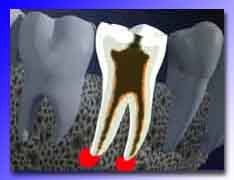
If decay is allowed to progress until it reaches the pulp chamber, the nerves and blood vessels become infected. The infected blood vessels in the pulp chamber and root canals can no longer provide nutrients to the tooth or fight the infection. As this infection continues, an abscess forms at the ends of the roots. This abscess causes bone destruction and can spread to other areas of the head.
The treatment for an infected tooth is to remove the infected tissue from the pulp chamber and root canals and to fill the area with a filling material. This procedure is commonly called a root canal. Dentists call it an endodontic procedure.
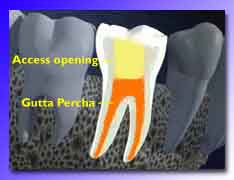
A tooth which has been endodontically treated (root canal), should have a crown (cap). The access opening into the tooth, which is necessary to do the root canal procedure, can leave the tooth weakened and susceptible to fracture. A crown protects the tooth against fracture. It is best to avoid root canal procedures by having cavities filled before they infect the pulp chamber. If you do need a root canal, don't be afraid. The majority of root canal procedures are no more painful than a filling.
Periodontal Services
Your teeth are intended to last a lifetime - and they can with proper care. Implant & General Dentistry offers non-surgical treatments to remedy gum inflammation and gum disease and we refer to specialists when necessary.
Periodontal Dentistry
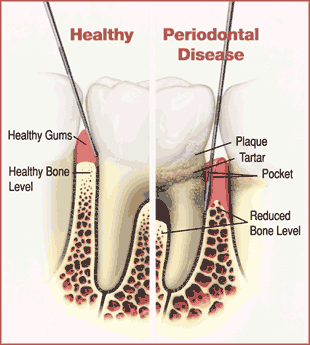
Infection of the gums can be a serious threat to your teeth and also to your overall health. Untreated periodontal infection has recently been recognized as a risk factor in heart disease….as significant a risk factor as high cholesterol or smoking.
Some of the warning signs of periodontal disease include bleeding gums, recession, loose teeth, bone loss and bad breath or taste.
We take periodontal disease very seriously. At your initial exam your will be screened for periodontal problems, and if necessary, a treatment plan that fits your needs will be developed for you. Non-surgical treatments are available at our office and your treatment could include any or all of the following:
1.) Thorough charting of pockets around teeth and any recession of gums
2.) Scaling and root planing to remove infection causing bacteria from tooth and root surfaces.
3.) Irrigation with antibacterial agents to ensure the harmful bacteria is eliminated and to promote healing.
4.) Home care instructions to help the gums to heal and to prevent any future problems with gum infections.
5.) Re-valuation including a re-exam of pockets and another plaque sample. At this time patients are put on a recall for three to four months or referred to a gum specialist if necessary (periodontist).
Do your gums bleed when brushing?
Are your gums receding?
Are your teeth sensitive to temperature changes?
All of the above are signs of periodontal disease. This disease does not cause any pain until the last stage when your teeth begin to loosen. Schedule an initial consultation online by clicking here.

